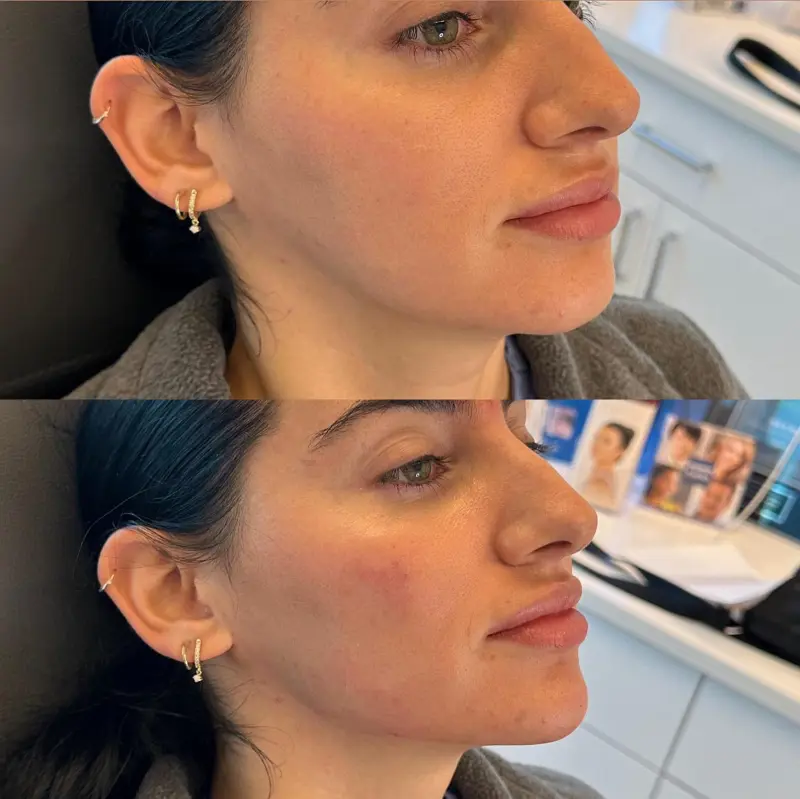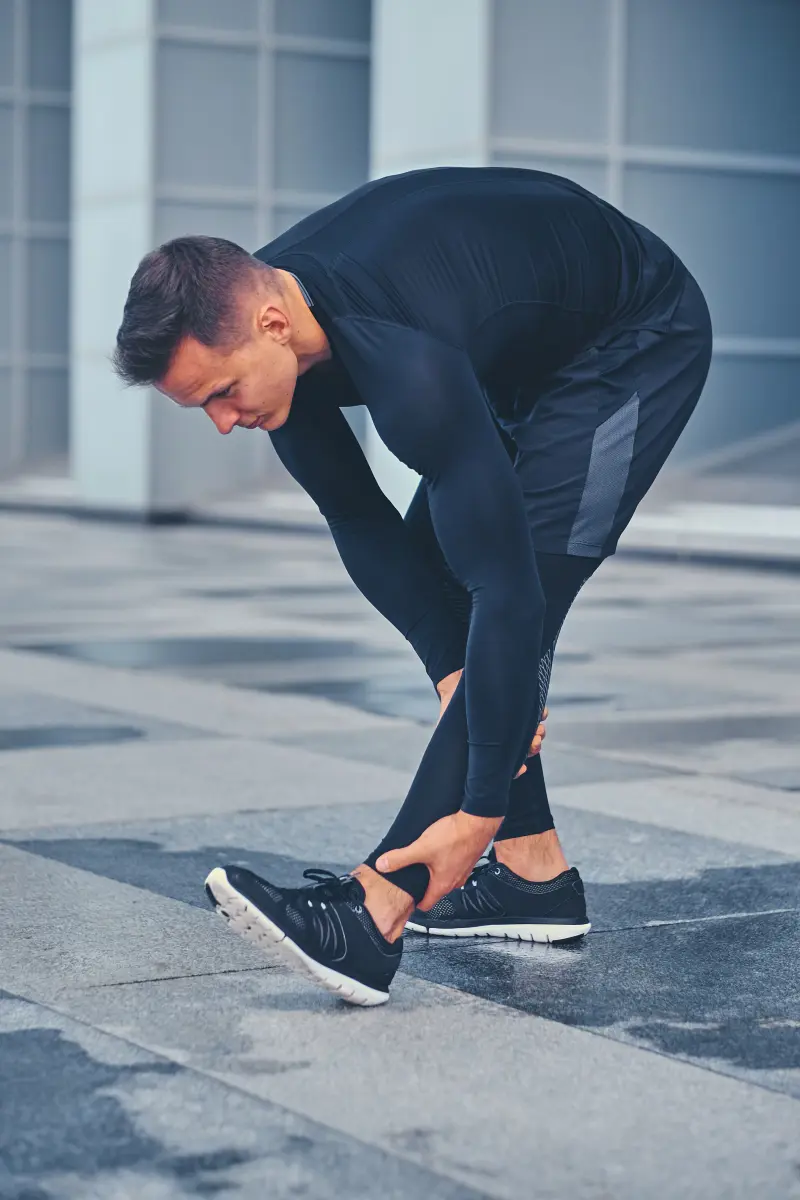12 Gluteus Medius Exercises For Stronger And Flexible Hips
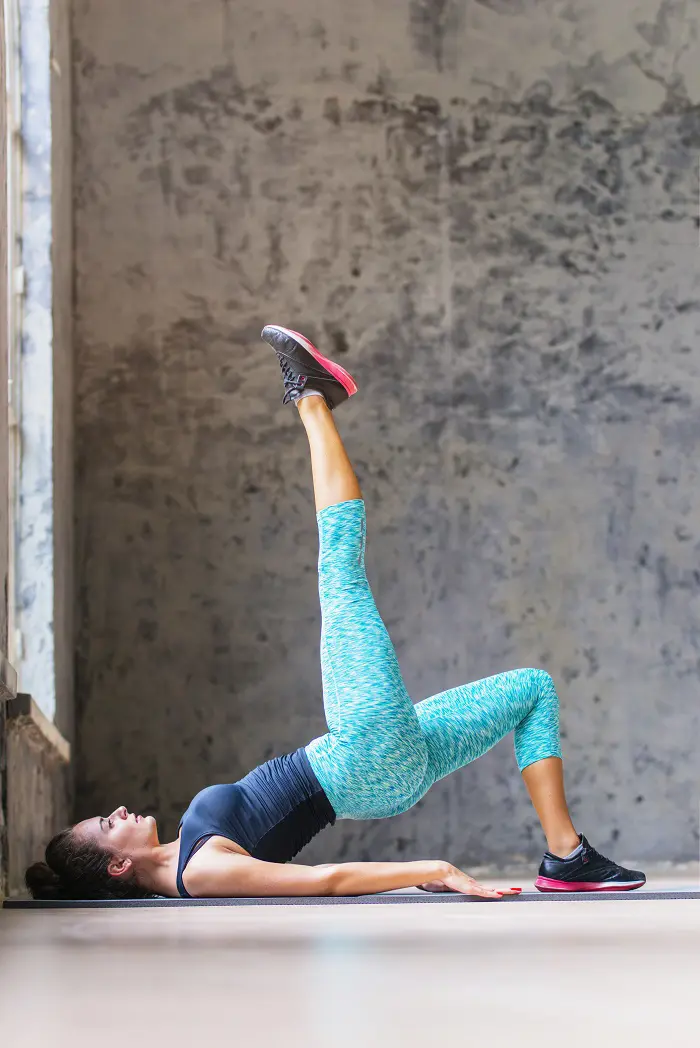
The gluteus medius muscle, present in the outer hips, plays a key role in everyday activities like walking, running, and squatting. If this muscle is strong, these activities will feel much easier.
Strengthening this muscle is also essential for stabilizing the pelvis and alleviating hip pain. So, here are 12 gluteus medius exercises to try for boosting hip strength and flexibility:
1. Single-Leg Bridge
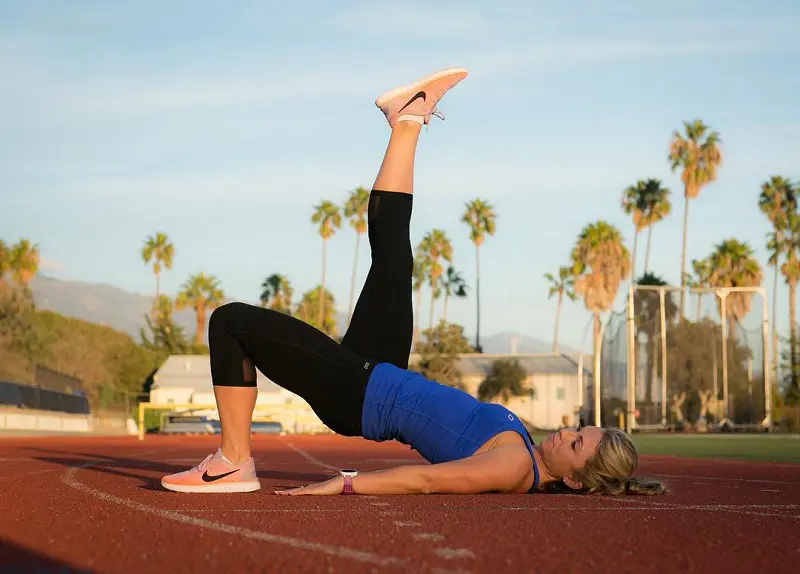
Let’s kick off the list with single-leg bridge, a traditional glute bridge variation that effectively activates the gluteus medius muscles to develop stronger hips.
We could add an ankle weight to the lifted leg to add more intensity to this exercise. However, it’s important to be careful if we have lower back pain as it could quickly worsen our discomfort.
Steps To Do It:
- Lie on your back with both legs straight and back flat. The feet must be firmly planted on ground.
- Now, bend the knees, keeping your arms at your sides.
- Start lifting your left leg slowly until it reaches a 45 to 90-degree angle.
- Keep the lifted leg completely straight. However, if you have any discomfort in the lower body, you can slightly bend the knee.
- Raise the hips off the floor by pressing your feet.
- The hips, legs, and back should be present in straight line.
- Hold this pose for 30 seconds and then lower down.
- Do this activity for 7-10 times and then switch the legs.
2. Lateral Step-Up

This exercise is quite simple: you only need to perform sideways step movements on an elevated platform.
We could add an extra challenge by increasing the height of the platform, or maybe try this exercise with a dumbbell or kettlebell in hand.
Steps To Do It:
- Stand tall (and sideways) beside an elevated platform - a plyo box or step platform is good.
- Step sideways with the help of the leg closest to the platform.
- Don’t touch the other leg with the elevated surface. It should hover on the ground.
- This means that you have to balance your body with one foot.
- Stay in this pose for 30-40 seconds.
- Come back down with the hovering leg first, followed by the other foot.
- Continue doing lateral step-ups for 7-10 reps, then exercise the other side.
3. Clamshells
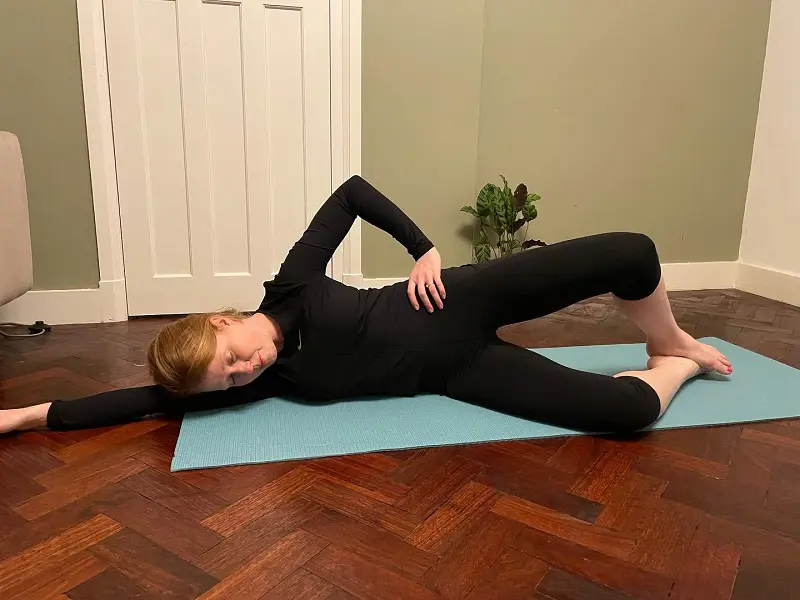
Want to try a unique exercise that mimics the opening of a clamshell? This gluteus medius workout is easy to do and doesn’t require any expensive gym equipment. Just a small space in your home is enough.
If Clamshells feel a bit too easy for you, try adding a resistance band for an extra challenge in order to burn muscles more effectively.
Steps To Do It:
- Lie down on the ground on your sides.
- Keep the legs stacked on top of one another. The feet should touch each other.
- Slightly bend both the knees at a 45-degree angle.
- Now, start lifting the top knee slowly and steadily.
- Raise the knee as high as possible. This motion will look like the opening of the clamshell.
- Hold at the top for a few seconds before lowering the leg.
- Repeat this move for 10 reps and then practice on the other side.
4. Standing Hip Abduction

To work the gluteus medius, standing hip abductions are a fantastic addition to our daily routine. In this exercise, the goal is to move our hip outward, and from a standing position, it can really activate the gluteus medius.
We must remember to keep a steady pace when swinging our legs, as fast swings can shift our hips and disrupt a healthy form.
Steps To Do It:
- Begin by standing with a straight back and relaxed shoulders. Keep the arms at your sides.
- Engage the core and glutes, and then begin to lift the right leg sideways.
- Focus only on the swinging leg, not on the balancing one.
- Continue moving the right leg as high as you can.
- Hold at the top for 30 seconds.
- If you feel difficulty balancing on one foot, take the support of a chair.
- Return the lifted leg to the original position and repeat 7-10 times.
5. Lateral Band Walk

One of the best exercises for gluteus medius, a lateral band walk can make your hips more flexible. It is crucial to loop a resistance band around your legs for this workout, so grab a quality band ready before getting into position.
Steps To Do It:
- Loop a resistance band around your legs, preferably above the ankles.
- Spread your legs a little wider than shoulder width distance.
- The legs should not be spread in such a manner that the band becomes hard to control.
- Bend the knees and slightly lower the body. You can join your hands at chest level.
- Take a small step to the side with your right leg, feeling the stretch with the resistance band.
- Then, move the left leg. Continue going in a lateral direction for 10-12 steps.
- Next, move in the opposite direction for the same reps.
6. Hip Thrusts
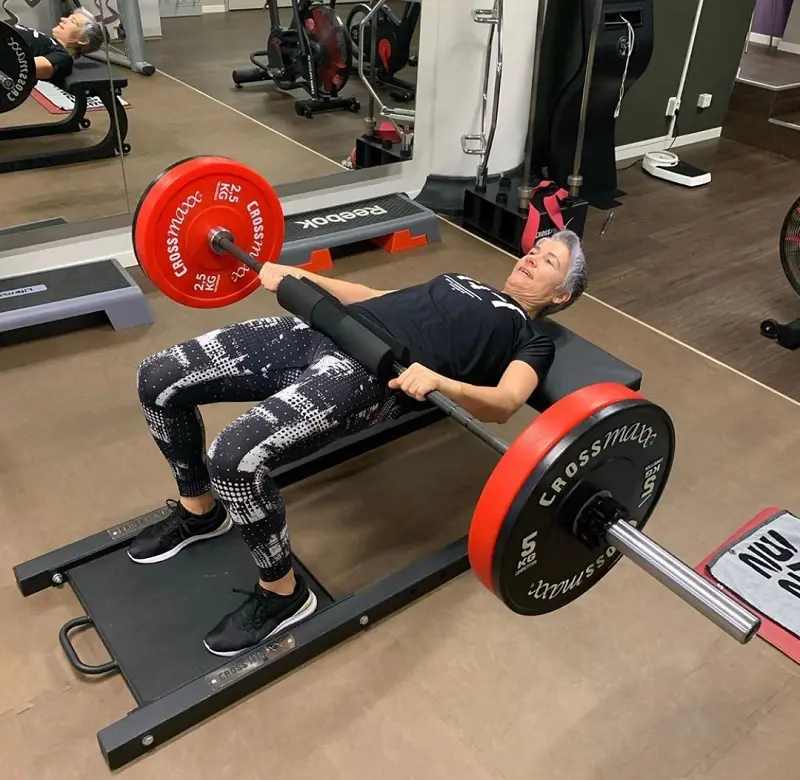
The hip thrust is a great workout that can be enhanced by adding a barbell. This exercise effectively targets the gluteus medius, along with the gluteus maximus, adductors, and core.
Doing it consistently can help you build strong, toned glutes and stabilize your core as well.
Steps To Do It:
- Sit beside a flat bench, resting your shoulders and upper back only.
- The knees must be bent and the feet firm on the floor.
- Grab a barbell and position it right above the hips.
- Take a deep breath, and start lifting the hips by pressing your feet. There is no need to raise the barbell.
- Raise yourself up until the legs, back, and shoulders make a straight line.
- Stay in this position for a few seconds before lowering the hips.
- Continue practicing the hip thrust workout for 7-10 reps.
7. Side Plank With Side Leg Lift

Side planks are great for core stability; combining them with a side leg lift engages our glutes too. This makes it one of the top moves for targeting the gluteus medius.
We can practice this workout anywhere - whether at home or in the gym. It may feel challenging to balance our body initially, but once we get the hang of it, this exercise becomes a fantastic addition to our routine.
Steps To Do It:
- Get into a side plank position through laying on your side, with an elbow supporting your entire body.
- Stack both legs on top of each other.
- Now, squeeze your glutes and slowly lift the top leg with slow, controlled motions.
- Keep the body stable while raising the leg.
- Once raised to the maximum height possible, stay there for 10 seconds.
- You can also extend your free arm to get a deeper stretch.
- Then, lower the leg back down.
- Perform this exercise for 10 reps. Then, switch sides and repeat.
8. Donkey Kicks

When you perform donkey kicks, be careful not to arch your back as it could lead to pain in the lower back. Instead of relying on momentum, you should lift the leg slowly to engage the gluteus medius muscles more effectively.
Donkey kicks are also great for targeting the gluteus maximus and core, hence contributing to pelvis stability and hip flexibility.
Steps To Do It:
- Get into a table top position with the palms under your shoulders and knees under the hips.
- Engage the core, and start kicking backward with the left leg.
- When lifting the leg, remember to maintain the bend in the knee.
- The left foot must go above the hip level, with the soles pointed toward the ceiling.
- Remember to keep the right knee on the ground while kicking the left one.
- Hold at the top for 10 seconds, then lower the leg down.
- Continue this process for the other leg too.
- Practice 7-10 reps for each side.
9. Single-Leg Wall Lean

This isometric exercise can be added to your routine to strengthen the gluteus medius. Standing parallel to the wall with one leg bent can also help improve your balance.
The deeper you lean into the wall, the more stretch you'll feel in your glutes. Just remember not to twist your hips while practicing this simple move.
Steps To Do It:
- Stand upright beside a wall, facing your left side.
- Maintain a straight back and relaxed shoulders before getting into position.
- Next, lift the left leg through bending the knee.
- Lean the upper body and the bent leg towards the wall.
- Press the right foot to drive the bent left knee into the wall.
- Stay in this position for 30 seconds to a minute.
- Lower the left leg and continue the process for 5-7 times.
- Rest for a while, then, repeat on the other side.
10. Fire Hydrant

Imagine a dog peeing on a fire hydrant. This exercise for the gluteus medius mimics that same movement. It’s a powerful glute stretcher that can be easily done at home.
You can add a resistance band to increase the intensity. However, don’t overcompensate the spine for the sake of stretching since it could result in terrible muscle strain.
Steps To Do It:
- Begin by setting yourself in a tabletop pose. Maintain a tight core and flat back.
- Now, raise the right knee slowly without losing the bend.
- Raise the knee sideways to mimic the movement of the dog.
- Lift your leg to 90-degree angle and hold it there. The knee should be parallel to your shoulders.
- Hold this pose for 10 seconds, then slowly get back to starting position.
- Complete 10-12 reps on the right side, then alternate to the left one.
11. Single-Leg Dead Lift

Do you want to try a challenging workout to strengthen the glute medius muscle? Single-leg deadlift is a great choice for this matter. Here, you'll need to balance weights on one leg, which may be pretty tough for beginners.
But with consistent practice, you'll get used to it, while also increasing your hip flexibility and improving balance and coordination.
Steps To Do It:
- Grab two light / medium-sized kettlebells and stand straight.
- Put one leg completely firm on the floor, keeping the other leg hovering just above the ground.
- Move the hovering leg behind you while maintaining a straight back.
- Extend the leg fully behind you and let your arms go down straight, holding the dumbbell.
- Balancing on one leg, hold this pose for 10 seconds.
- Return to starting position and repeat for desired number of reps.
- When you finish on one side, switch to the other leg.
12. Single-Leg Squat
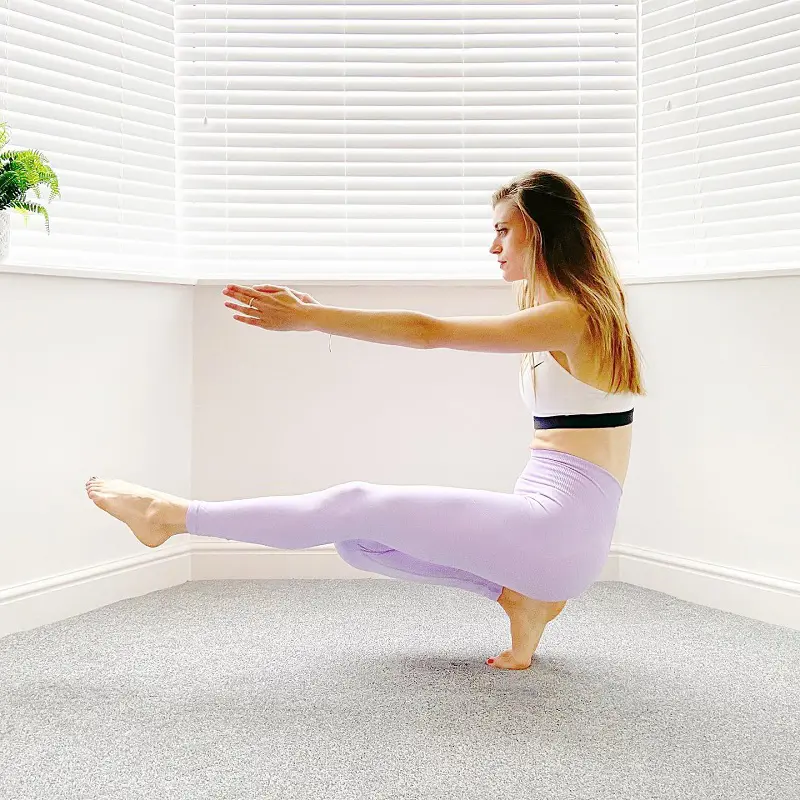
This might be the toughest workout on this list. Squatting on one leg isn’t easy, but if you nail the technique, it could become your secret weapon for strengthening and enhancing the flexibility of your glute medius.
Before attempting this workout, make sure your balance skills are on point - as it demands a lot of stability!
Steps To Do It:
- Begin in a standing pose with your arms extended and lying in front of you.
- Lift the left leg off the ground while slightly bending the right leg’s knee.
- Lower the hips slowly until you fully bend the right leg.
- Maintain an erect spine during the entire process.
- While balancing on your right foot, maintain the squat for a few seconds.
- Then, push through your right foot to raise your body back up.
- Do this activity for desired number of reps.
Safety Tips And Precautions
1. Follow The Instructions Properly
The first thing you need to note is the technique or form. Without correct form, any exercise will just become redundant. In fact, it could lead to injuries like muscle strain or cramps.
So, before committing to the aforementioned workouts, understand their correct techniques so that you can get the most out of them.
2. Progress Gradually
There is no need to increase the intensity of an exercise right off the bat. Your muscles may not have warmed up properly, so beginning the session with gentle movements is a must.
When you have done the workout for a few minutes, you can then gradually introduce challenges and additional reps to give your muscles better stretch.
3. Take Deep Breaths
Do not forget to take deep breaths throughout the exercise movements. You could try various breathing techniques to make your workout session more interesting. When you breathe properly, more oxygen will reach the brain and muscles, enhancing your performance.
When To Consult A Doctor?
Many unexpected situations may arise when practicing these glute medius exercises. In such cases, you would need to consult a doctor. Here are some of the situations:
- Feeling of Sharp Pain - If we feel a sharp, stinging pain in the glute med muscles while doing these aforementioned workouts or post-workout, it might be time to visit a doctor to understand the situation.
- Numbness in the Legs - Sometimes, working out the glutes can cause a feeling of numbness in the legs. This might happen due to nerve compression. Be sure to check with your healthcare professional to address it.
- Lack of Improvement - Reach out to a doctor if you don't see improvement in the development of your glute muscles after multiple sessions. They can provide specific guidance on whether you need to adjust your workout routine.
Recent posts
Exercises
Exercises
12 Amazing Full Body Dumbbell Workout And Exercises
If you're new to fitness, putting together a full-body workout can feel overwhelming. A solid training program targets strength, endurance, flexibility, and balance while working all the major muscle groups. Luckily, dumbbells are versatile tools tha...
Exercises
11 Effective Jawline Exercises To Try For A Chiseled Face
Jawline exercises can lead to changes in the shape of the face, resulting in fuller cheeks and a more youthful appearance. Exercising the neck, chin, jaw, and other facial muscles leads to sharper cheekbones and a prominent jawline. Improving your ja...
Exercises
15 Best Exercises For Waist To Get A Slimmer Midsection
Smaller waist is a common goal for many women, but it requires a mix of exercise, persistence, and a healthy lifestyle. Waist-slimming workouts will tone and shape your midsection while also improving your overall posture and stability. From easy twi...
Exercises
16 Body Weight Leg Exercises To Strengthen Your Lower Body
Bodyweight training is very accessible, popular, and requires little or no equipment at all. With bodyweight exercises, you can target your lower body muscles in different ways to help build stronger legs. Before jumping into weighted movements, thes...
Exercises
12 Achilles Tendon Stretches To Tone Heel And Calf Muscles
The Achilles tendon runs down the back of the lower leg, connecting the heel bone to the calf muscle. It helps lift the heel off the ground while walking. If you suffer from Achilles tendonitis, gently working out the inflamed tendons can aid in quic...
Exercises
15 Landmine Exercises To Increase Your Functional Strength
A landmine is a barbell anchored to the floor with a weight on the other end. The angle of the bar allows you to apply force vertically and horizontally. Landmine exercises are beneficial for those seeking joint-friendly alternatives to traditional l...

